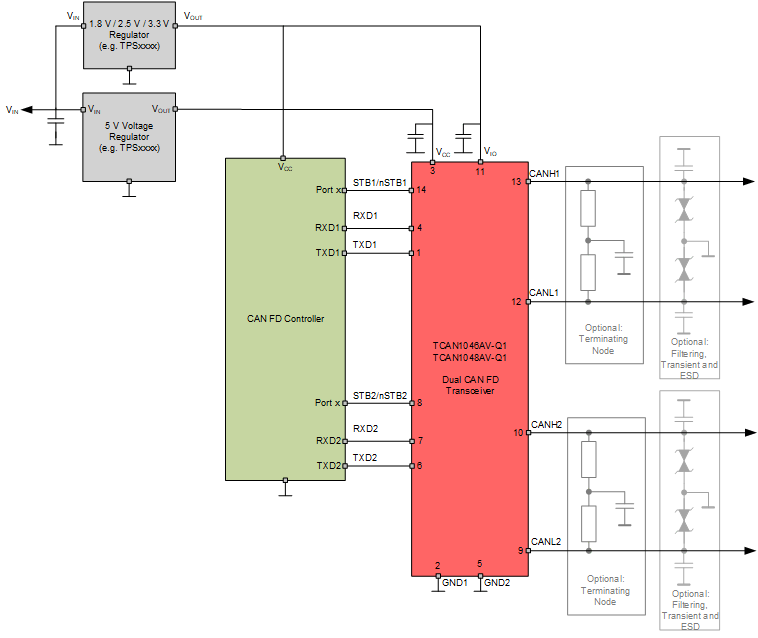SLLSFL8A July 2021 – December 2021 TCAN1046AV-Q1 , TCAN1048AV-Q1
PRODUCTION DATA
- 1 Features
- 2 Applications
- 3 Description
- 4 Revision History
- 5 Description Continued
- 6 Device Comparison
- 7 Pin Configuration and Functions
- 8 Specifications
- 9 Parameter Measurement Information
-
10Detailed Description
- 10.1 Overview
- 10.2 Functional Block Diagram
- 10.3 Feature Description
- 10.4 Device Functional Modes
- 11Application and Implementation
- 12Power Supply Recommendations
- 13Layout
- 14Device and Documentation Support
- 15Mechanical, Packaging, and Orderable Information
Package Options
Mechanical Data (Package|Pins)
Thermal pad, mechanical data (Package|Pins)
Orderable Information
3 Description
The TCAN1046AV-Q1 and TCAN1048AV-Q1 (TCAN104xAV-Q1) are dual, high-speed controller area network (CAN) transceivers that meet the physical layer requirements of the ISO 11898-2:2016 high-speed CAN specification.
The TCAN104xAV-Q1 transceivers support both classical CAN and CAN FD networks up to 8 megabits per second (Mbps). The device includes internal logic level translation via the VIO terminal to allow for interfacing the transceiver I/O's directly to 1.8-V, 2.5-V, 3.3-V, or 5-V logic levels.
The two CAN channels support independent mode control through the standby pins. Therefore, each transceiver can be placed into a low-power state, standby mode, without impacting the state of the other CAN channel. While in standby mode, the device supports remote wake-up pattern via the CAN bus which is compliant to the ISO 11898-2:2016 defined wake-up pattern (WUP).
| PART NUMBER | PACKAGE(1) | BODY SIZE (NOM) |
|---|---|---|
| TCAN1046AV-Q1 | VSON (14) | 4.50 mm x 3.00 mm |
| SOIC (14) | 8.65 mm x 3.91 mm | |
| SOT-23 (14) | 4.20 mm × 2 mm | |
| TCAN1048AV-Q1 | VSON (14) | 4.50 mm x 3.00 mm |
| SOIC (14) | 8.95 mm x 3.91 mm |
 Simplified Schematics
Simplified Schematics